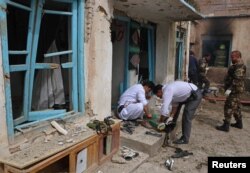Insurgent attacks have killed 252 Afghan troops during the past week and wounded about 400 others.
The Afghan defense and interior ministers, along with the spy chief, released the figures Monday while briefing parliament on the deteriorating security situation since the Taliban insurgency launched its annual "spring offensive" about two weeks ago.
This was the first time in many months officials have reported casualty numbers for Afghan forces.
The ministers told lawmakers that, since the end of April, Afghan forces have inflicted heavy casualties on the armed opposition, killing about 800 insurgents and wounding 500 others. They say more than 2,600 insurgent attacks were plotted against Afghan military and police forces, but that nearly 70 percent of them were foiled.
The Taliban's offensive has led to a sharp escalation in battlefield attacks and suicide bombings, which have become routine during the warmer months of the 17-year war.
Afghan forces suffered unprecedented casualties in 2017, reportedly losing about 10,000 personnel.
Thinning security force
The U.S. Special Inspector General for Afghanistan Reconstruction, or SIGAR, reported last week the number of Afghan security forces declined by nearly 11 percent during the past year due to violence and desertions.
In 2017, the Afghan National Police shrank by more than 23,000 people while the Afghan National Army saw a decline of nearly 2,820 people.
SIGAR said the Afghan government controls just over half of the country's 407 districts, despite an expanded U.S. military campaign in support of local security forces.The Taliban control or contest the rest of the territory, the highest level recorded since 2015, according to the watchdog group.
U.S. President Donald Trump's Afghan war strategy announced in August has led to an increase in the number of American troops and airstrikes to contain insurgent advances.
Observers say the new policy has impacted the stalemate and anticipate more bloodshed during this year's fighting.
Islamic State's Afghan affiliate, the Khorasan Province, or IS-K, has also increased attacks against civilians and military targets in the country, adding to the challenges facing the U.S.-backed Afghan government.
In the last week of April, IS plotted two major suicide bombings targeting an election identification card distribution center in Kabul and a group of journalists covering a bomb attack in the capital city.The attacks claimed nearly 90 civilian lives and wounded nearly 150 others.
On Sunday, a bomb explosion ripped through a mosque used as a voter registration center in the southeastern Khost province, killing 17 people and wounding dozens more.No one claimed responsibility.
The rise in violence has raised concerns about security during Afghan parliamentary and district council elections scheduled for October 20.














